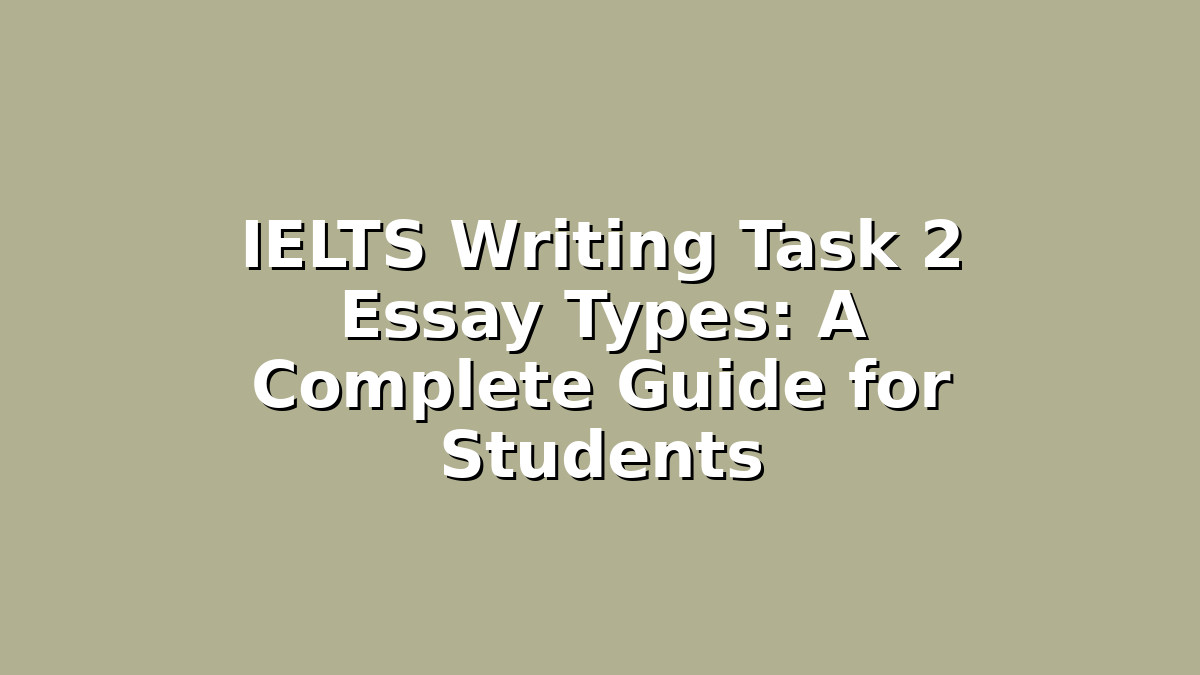Preparing for the IELTS exam can feel overwhelming, especially when it comes to the writing section. Among all the components, Writing Task 2 often poses the greatest challenge for students. This task requires you to write a formal essay of at least 250 words within 40 minutes, addressing a particular question or statement. But did you know that understanding the different IELTS Writing Task 2 essay types can make your preparation much more effective?
In this blog post, we’ll explore the main IELTS Writing Task 2 essay types, provide detailed study-related advice for each, and share tips on how to approach them confidently. Whether you are a beginner or aiming for a high band score, this guide will help you grasp the nuances of each essay type and improve your writing skills.
—
Understanding the IELTS Writing Task 2 Essay Types
IELTS Writing Task 2 essays usually fall into five major categories:
1. Opinion Essays (Agree or Disagree)
2. Discussion Essays
3. Problem-Solution Essays
4. Advantages and Disadvantages Essays
5. Direct Question Essays
Knowing your essay type helps you organize your response logically and address the question correctly. Let’s explore each type in detail.
—
1. Opinion Essays (Agree or Disagree)
What is it?
Opinion essays ask you to clearly state your viewpoint on a statement or question and support your opinion throughout the essay. The prompt typically includes phrases like “To what extent do you agree or disagree?”
How to approach it:
– Clearly state your opinion in the introduction: Decide if you fully agree, fully disagree, or partially agree with the statement.
– Use topic sentences to express your main points: Each paragraph should support your opinion with reasons, examples, or evidence.
– Include a balanced view if required: Sometimes it helps to acknowledge the opposing side briefly but reiterate your stance strongly.
– Conclude by summarizing your opinion: Reinforce your position clearly without introducing new ideas.
Study Tips:
– Practice writing clear thesis statements and avoid vague opinions.
– Work on developing strong arguments that back your opinion.
– Use linking words like “however,” “therefore,” and “in contrast” to make your essay coherent.
– Review sample opinion essays to understand structure and vocabulary.
—
2. Discussion Essays
What is it?
Discussion essays require you to explore two or more viewpoints related to a statement or question. You need to present both sides fairly before giving your own opinion, if asked.
How to approach it:
– Introduce the topic and outline both views: Your introduction should mention the discussion points without bias.
– Devote separate paragraphs to each viewpoint: Explain each perspective clearly with supporting evidence.
– State your opinion (if asked): This usually comes in the conclusion or a separate paragraph after the discussion.
– Avoid taking sides until you have presented balanced arguments: This shows critical thinking and fairness.
Study Tips:
– Practice writing balanced paragraphs that objectively present different opinions.
– Build a strong vocabulary for expressing agreement, disagreement, contrast, and comparison.
– Time yourself to write balanced essays within the 40-minute limit.
– Analyze band 8+ discussion essays to notice how opinions and evidence are presented.
—
3. Problem-Solution Essays
What is it?
Problem-solution essays ask you to describe a problem related to a topic and suggest one or more solutions.
How to approach it:
– Clearly identify the problem in the introduction: Explain why it is important or how serious it is.
– Describe the problem in detail: Use one or two paragraphs to analyze the causes and effects.
– Offer practical solutions: Devote a paragraph or two explaining feasible ways to solve the problem.
– Support solutions with examples or reasons: This shows the solutions are realistic and effective.
– Summarize the problem and solutions in the conclusion: Reinforce the importance of taking action.
Study Tips:
– Practice brainstorming problems and solutions related to common IELTS topics like environment, education, or technology.
– Learn to use vocabulary related to causes, effects, and solutions (e.g., “lead to,” “result in,” “implement,” “promote”).
– Work on linking ideas clearly using phrases like “as a result,” “one possible solution is,” and “to address this issue.”
– Write multiple problem-solution essays to develop fluency and clarity.
—
Additional Tips for Mastering IELTS Writing Task 2
Regardless of the essay type, some strategies will help you perform better:
– Understand the prompt carefully: Make sure you identify the essay type and what the question asks.
– Plan before you write: Spend 5–10 minutes outlining your essay’s structure and main ideas.
– Use formal language: Avoid slang and contractions; use academic vocabulary.
– Vary your sentence structure: Mix simple, compound, and complex sentences to improve readability.
– Check your work: Leave a few minutes to revise grammar, spelling, punctuation, and word count.
—
Conclusion
Mastering IELTS Writing Task 2 essay types is a crucial step towards achieving your desired band score. By understanding whether the question asks for your opinion, a discussion of views, or a problem-solution approach, you can organize your essay more effectively and write with clarity. Practice regularly, review model essays, and apply the tips mentioned here to build confidence and improve your writing skills.
Remember, preparation is key. The more you familiarize yourself with these essay types, the more comfortable and efficient you’ll become on test day. Keep practicing, stay positive, and believe in your ability to succeed!
—

Responses